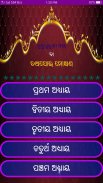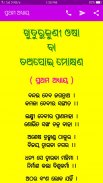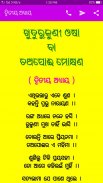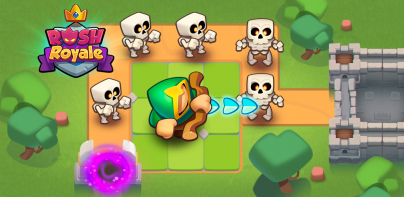









Khudurukuni Osha

Descrizione di Khudurukuni Osha
On the Sundays of the month of Bhadrab (Aug-Sept) this festival is observed by the
unmarried girls of the business community of the coastal districts of Orissa. During the
festival Goddess Durga is propitiated Khude Bhaja (Left out particles of rice that are
fried), Kantiali Kakudi (Cucumber having little thorns on it), Lia (fried paddy),
Ukhuda(fried paddy sweetened by molasses) and coconut are the food-offerings given
to the deity. However, the principal food-offering is Khuda which is said to be the
favourite of the Goddess. Therefore, the festival is named as "Khudarankuni" or popularly
'Khudurkuni' which means one who is very eager for khuda.
In the early morning the girls go out collecting flowers required for the ritual. The varieties
are Kaniara, Godibana, Tagara, Malati, Champa, Mandera and Kain. Then they go
to nearby rivers and tanks to have purificatory bath. After this they build tiny temples of
earth or sand and decorate the same with flowers. Paying obeisence to the deity there,
they return to their respective homes. They take two and half mouthfuls of boiled rice
mixed with water without adding salt. Then salt is added. The significance of this act is
not known. After this the, whole day is spent in making garlands and decorating the
image of the Goddess.
In villages generally the deity is worshipped in the Dhinkisala or the place where caddy
is pounced. This place is plastered neatly with cow-dung and the image of the deity is
installed. The floor is painted with floral despins known as Jhoti or Alpana. Garlands
are made to hang like arches. The whole day passes with the arrangement and the rituals
of worship commence in the evening.
After the ritual, are over the girls recite musically the episode of Taapoi which is now
available in print. Eariler this was handed down by oral tradition. The first episode
'Malasri' recounts the killing of the demon by Durga. It is said, that Mahisasura, the terrible
demon became atrocious by getting a boon from Brahma, the creator. Not only
the mankind, but also the Gods got panicky. He became so powerful that even Gods
couldn't kill him. Then all the Gods conferred and went to request the Goddess of
power to kill the demon. Durga agreed and assuming the form of a beautiful damsel
went to Vindhya mountain to pretend penancing. Mahisasura, while out on hunting,
noticed the beautiful damsel and immediately offered to marry her. The damsel
answered that she would only marry that person who would defeat her in duel. Mahisasura
being confident of his power soon agreed to the proposal. A fierce 'duel' ensued
between them; with all her enargy the damsel thrusted a trident violently to the chest of
the demon who was killed. Thus, Durga redeemed the world from the fear and atrocity
of the demon. It is, therefore, believed that the girls worship Durga to be powerful like
Her, to fight evil forces for the goodof the human race.
La domenica del mese di Bhadrab (agosto-settembre) questo festival viene osservato dal
ragazze non sposate della comunità imprenditoriale dei distretti costieri dell'Orissa. Durante
festival Dea Durga è propiziato Khude Bhaja (lasciato fuori particelle di riso che sono
fritto), Kantiali Kakudi (cetriolo con piccole spine), Lia (risaia fritta),
Ukhuda (risaia fritta addolcita dalla melassa) e cocco sono le offerte di cibo offerte
alla divinità. Tuttavia, la principale offerta di cibo è Khuda che si dice sia
favorito della Dea. Pertanto, il festival è chiamato "Khudarankuni" o popolarmente
'Khudurkuni' che significa uno che è molto desideroso di khuda.
Al mattino presto le ragazze escono raccogliendo i fiori necessari per il rituale. Le varietà
sono Kaniara, Godibana, Tagara, Malati, Champa, Mandera e Kain. Poi vanno
ai fiumi e ai carri armati vicini per fare il bagno purificatore. Dopo questo costruiscono minuscoli templi di
terra o sabbia e decorare lo stesso con i fiori. Pagando l'ubbidienza alla divinità lì,
ritornano alle loro rispettive case. Prendono due bocconi e mezzo di riso bollito
mescolato con acqua senza aggiungere sale. Quindi viene aggiunto sale. Il significato di questo atto è
non conosciuto. Dopo questo, l'intera giornata è trascorsa nel fare ghirlande e decorare il
immagine della Dea.
Nei villaggi in genere la divinità è venerata nel Dhinkisala o nel luogo in cui caddy
è avventato. Questo posto è intonacato ordinatamente con sterco di vacca e l'immagine della divinità è
installato. Il pavimento è dipinto con despins floreali noti come Jhoti o Alpana. ghirlande
sono fatti per appendere come archi. L'intera giornata trascorre con la disposizione e i rituali
il culto inizia la sera.
Dopo il rituale, sono finite le ragazze che recitano musicalmente l'episodio di Taapoi che è ora
disponibile in stampa. Eariler questo è stato tramandato dalla tradizione orale. Il primo episodio
'Malasri' racconta l'uccisione del demone da parte di Durga. Si dice che Mahisasura, il terribile
il demone divenne atroce ottenendo un vantaggio da Brahma, il creatore. Non solo
il genere umano, ma anche gli dei si sono fatti prendere dal panico. È diventato così potente che persino gli dei
non potevo ucciderlo. Quindi tutti gli dei conferirono e andarono a chiedere la Dea di
potere di uccidere il demone. Durga accettò e assunse la forma di una bella damigella
andò sulla montagna di Vindhya per fingere di penzionare. Mahisasura, mentre è fuori a caccia,
notò la bella damigella e si offrì immediatamente di sposarla. La damigella
rispose che avrebbe sposato solo quella persona che l'avrebbe sconfitta in duello. Mahisasura
essere fiducioso del suo potere ha presto accettato la proposta. Ne conseguì un feroce "duello"
fra loro; con tutta la sua enigma la fanciulla spinse violentemente un tridente sul petto di
il demone che è stato ucciso. Quindi, Durga ha redento il mondo dalla paura e dalle atrocità
del demone. Pertanto, si ritiene che le ragazze adorino Durga come una persona potente
Lei, per combattere le forze del male per il bene della razza umana.


























